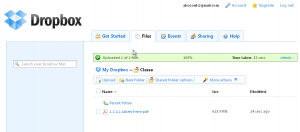People aren’t using bulky cameras hung around their necks to snap the majority of photos taken these days, nor are they doing a lot of their office work in all of the conventional places. Using smart phones and tablets, users are uploading thousands of photos onto Instagram daily and effortlessly attaching files and sending emails while sitting in the backseat of a cab. How is this digital, file-sharing, wireless world possible? The answer is through cloud sharing.
All those files have to be stored somewhere, and the world of file sharing and cloud storage is expanding making it easier to share photos, files, contacts, calendars and more. Here’s what’s happening:
Gmail Uses Google Drive
Gmail and other smtp systems are jumping on the cloud storage bandwagon and pushing smaller start ups to jump ship or quickly improve. Using Google’s Drive storage system, Gmail now allows its users to send files as large as 10 gigabytes. The new feature requires no set up but will automatically be available upon signing into your account. When attaching a file, Gmail will check that your recipient has permission to view the files in Google Drive. If they don’t, Gmail will prompt you to change your sharing settings.
This may sound like bad news for Dropbox, Box, YouSendIt and other sharing services, because Dropbox’s free plan starts users at 2 GB of storage – far below Gmail’s new size limit. But Dropbox has a few secrets up its sleeve.
 Easier Photo Sharing through Dropbox
Easier Photo Sharing through Dropbox
According to the company’s blog, Instagram had its busiest day yet on Nov. 22 with 10 million photos shared that mentioned Thanksgiving-related words. At its peak around 12:40 p.m. PST, the site had 226 Turkey-day photos shared per second. That’s a lot of pictures taken via a mobile device, and Dropbox is inching its way into that market with its Camera Upload system. Using the app that works on Android or iOS devices, whenever you take a photo it will automatically upload to your Dropbox account. Not only will you have easy access to the photo on any device that you can access your account on, but you won’t ever have to worry about losing photos if your phone or tablet is lost or stolen.
That should’ve relieved any fears about losing photos, but here’s the sharing part. Dropbox is testing a feature that allows users to share photo folders with other Dropbox users through a tag system that works a bit like the one in Gmail. According to sociable.co, users can tag one image with multiple tags and it will appear in each tagged group. That way you can share photos with family and friends without giving them complete access to your camera’s album.
More Security and Control: Another Business Joins the Sky
Founded in 2007, Egnyte boasts its product that is similar to Dropbox but “with more security and control,” according to theregister.co.uk. The company’s targeted customer has sensitive data they want hidden behind a firewall but without the possibility of it being lost or unprotected. Egnyte’s Cloud Control is designed for file-sharing security, scalability and control. According to the company, the product uses existing file system structures, doesn’t force deployment of proprietary file systems and gives users direct access to local shares.
An Egnyte spokesperson told theregister.co.uk the product is comparable to a concierge service.
“I use concierge as an analogy because they know all the secrets in a building and can be trusted to keep them. If workers come in to fix the lift, the concierge will take them to the control room. Likewise, Egnyte can give the right employees the permission to access sensitive data,” it says on the site.
Right now Egnyte’s Cloud Control is an invitation-only beta test but is pushing to be publicly available toward the end of 2013’s first quarter, according to theregister.co.uk. By then, who knows what else will be floating around in the cloud sharing world.
